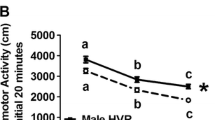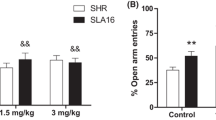Summary
Groups of two inbred strains of mice (C 57 Bl/6J and DBA/2J) with septal and control lesions were tested for morphine-induced analgesia and running activity (running fit). As previously observed the effects of morphine on the running fit and analgesia were strain-dependent and a negative strain correlation was evident between the two measures in C 57 and DBA operated control mice which are characterized by different brain levels and turnover of cholinergic and adrenergic mediators. Septal lesions, which cause a reduction in the levels of acetylcholine, in the brain areas which receive a cholinergic input from the septum, antagonized morphine analgesia in both strains while the running fit syndrome was unaffected. Pharmacological manipulation of brain catecholamines did not interfere with morphineinduced analgesia. The effects of different pharmacological agents which interfere with noradrenaline synthesis and catecholamine oxidation were assessed in the two strains which are characterized by presence (C57) or absence (DBA) of increased motor activity following the injection of morphine. The results argue against an exclusive association of morphine-induced motor activity with noradrenergic mechanism.
Similar content being viewed by others
References
Ayhan, I. H., Randrup, A.: Inhibitory effects of amphetamine, l-Dopa and apomorphine on morphine-induced behavioral excitation of rats. Arch. int. Pharmacodyn. 204, 283–292 (1972)
Bhargava, H. N., Chan, S. L., Way, E. L.: Morphine analgesia, tolerance and physical dependence: Effect of intercerebral hemicholinium-3 (HC-3). Fed. Proc. 31, 527 (1972)
Buxbaum, D. M., Yarbrough, G. G., Carter, M. E.: Biogenic amines and narcotic effects. I. Modification of morphine-induced analgesia and motor activity after alteration of cerebral amine levels. J. Pharmac. exp. Ther. 185, 317–327 (1973)
Cheney, D. L., Goldstein, A.: The effect of p-chlorophenylanine on opiate-induced running, analgesia, tolerance and physical dependence in mice. J. Pharmacol. exp. Ther. 177, 309–315 (1971)
Domino, E. F., Wilson, A.: Effects of narcotic analgesic agonists and antagonists on rat brain acetylcholine. J. Pharmacol. exp. Ther. 184, 18–32 (1973)
Ebel, A., Hermetet, J. C., Mandel, P.: Comparative study of acetylcholinesterase and choline-acetyltransferase enzyme activity in brain of DBA and C 57 mice. Nature New Biol. 242, 56–57 (1973)
Ehrenpreis, S., Greenberg, J., Belman, S.: Prostaglandins reverse inhibition of electrically-induced contractions of guinea-pigs ileum by morphine, indomethacin and acetylsalicylic acid. Nature New Biol. 245, 280–282 (1973)
Eddy, N. B., Leimback, D.: Synthetic analgesics II. Dithienylbutenyl-and dithienylbutylamines. J. Pharmacol. exp. Ther. 107, 385–393 (1953)
Giarman, N. J., Pepeu, G.: Drug induced changes in brain acetylcholine. Brit. J. Pharmacol. 19, 226–234 (1962)
Goldstein, A., Sheehan, P.: Tolerance to opioid narcotics. I. Tolerance to the “running fit” caused by levorphanol in the mouse. J. Pharmacol. exp. Ther. 169, 175–184 (1969)
Gray, J. A.: Sodium amobarbital, the hippocampal theta rhytm, and the partial reinforcement extinction effect. Psychol. Rev. 77, 465–480 (1970)
Hamilton, L. W., McCleary, R. A., Grossman, S. P.: Behavioral effects of cholinergic septal blockade in the cat. J. comp. Physiol. Psychol. 56, 563–568 (1968)
Herz, A., Albus, K., Metys, J., Schubert, P., Teschemaker, H.: On the central sites for the antinociceptive action of morphine and fentanyl. Neuropharmacology 9, 539–551 (1970)
Herz, A., Yacoub, F.: Hemming nociceptiver und bedingter Reaktionen durch Cholinomimetica im Vergleich mit der Wirkung anderer zentral angreifender Substanzen. Psychopharmacologia (Berl.) 5, 115–125 (1964)
Hollinger, M.: Effects of resperpine, α-methyl-p-tyrosine, p-chlorophenylalanine, and pargyline on levorphanol induced running activity in mice. Arch. int. Pharmacodyn. 170, 419–424 (1969)
Jhamandas, K., Pinsky, C., Phillis, J. W.: Effects of morphine and its antagonists on release of cerebral cortical acetylcholine. Nature (Lond.) 238, 176–177 (1970)
Jhamandas, K., Dickinson, G.: Modification of precipitated morphine and methadone abstinence by acetylcholine antagonists. Nature New Biol. 245, 219–221 (1973)
Karli, P.: Systéme limbíque et processus de motivation. J. Physiol. (Paris) 60, 148 (1968)
Kempf, E., Greilsamer, J., Mack, C., Mandel, P.: Correlation of behavioral difference in three strains of mice with differences in brain amines. Nature (Lond.) 247, 483–485 (1974)
Kuhar, M. J., Sethy, V. H., Roth, R. H., Agajanian, C. K.: Choline: Selective accumulation by central cholinergic neurons. J. Neurochem. 20, 581–593 (1973)
Kuhar, M. J., Pert, B. C., Snyder, S. H.: Regional distribution of opiate receptor binding in monkey and human brain. Nature (Lond.) 245, 447–450 (1973)
Mack, C., Greilsamer, J., Kempf, E., Mandel, P: Neurochemical correlates of genetically observed differences in performance levels in mice. Abstract IV Int. Meeting of the international society for neurochemistry, Tokio 1973
Mandel, P., Ebel, A., Hermetet, J. C., Bovet, D., Oliverio, A.: Etudes des enzymes du systeme cholinergique chez les hybrides F1 de Souris se distinguant par leur aptitude au conditionement. C. R. Acad. Sci. (Paris) 276, 395–398 (1973)
McCleary, R. A.: Response specificity in the behavioral effects of limbic system lesions in the cat. J. comp. physiol. Psychol. 54, 605–613 (1961)
Oliverio, A., Castellano, C., Messeri, P.: Genotype dependent effects of septal lesions on different types of learning in the mouse. J. comp. Physiol. Psychol. 82, 240–246 (1973)
Oliverio, A., Castellano, C.: Genotype-dependent sensitivity and tolerance to morphine and heroine: dissociation between opiate-induced running and analgesia in the mouse. Psychopharmacologia (Berl.) 39, 13–22 (1974)
Pepeu, G., Mulas, A., Ruffi, A., Sotgiu, P.: Brain acetylcholine levels in rats with septal lesions. Life Sci. 10, 181–184 (1971)
Pert, C. B., Snyder, S. H.: Opiate receptor: demonstration in nervous tissue. Science 179, 1011–1014 (1973)
Samanin, R., Valzelli, L.: Serotoninergic neurotransmission and morphine activity. Arch. int. Pharmacodyn. 196, 138–141 (1972)
Rethy, C. R., Smith, C. B., Villarreal, J. E.: Effects of narcotic analgesics upon the locomotor activity and brain catecholamine content of the mouse. J. Pharmacol. exp. Ther. 176, 472–479 (1971)
Sharkawi, M.: Effects of morphine and pentobarbitone on acetylcholine synthesis by rat cerebral cortex. Brit. J. Pharmacol. 40, 86–91 (1970)
Srebro, B., Oderfeld-Novak, B., Klodos, I., Dabrowka, J., Narkiewicz, O.: Changes in acetylcholinesterase activity in hippocampus produced by septal lesions in the rat. Life. Sci. 12, 261–270 (1973)
Villarreal, J. E., Guzman, M., Smith, C. B.: A comparison of the effects of d-amphetamine and morphine upon the locomotor activity of mice treated with drugs which alter brain catecholamine content. J. Pharmacol. exp. Ther. 187, 1–7 (1973)
Wey, E., Loh, H. H., Way, E. L.: Brain sites of precipitated abstinence in morphinedependent rats. J. Pharmacol. exp. Ther. 185, 108–115 (1973)
Way, E. L., Ho, I. K., Loh, H. H.: Relations of brain serotonin to the inhibition and enhancement of morphine tolerance and physical dependence. In: New concepts in neurotransmitter regulation. A. J. Mandell, ed.. New York: Plenum Press 1973
Winter, C. A., Flataker, L.: The effect of cortisone, desoxycortisterone, and adrenocorticotropic hormone upon the responses of animals to analgesic drugs. J. Pharmacol. exp. Ther. 103, 93–105 (1951)
Yarbrough, G. G., Buxbaum, D. M., Sanders-Bush, E.: Biogenic amines and narcotic effects. II. Serotonin turnover in the rat after acute and chronic morphine administration. J. Pharmacol. exp. Ther. 185, 328–335 (1973)
Author information
Authors and Affiliations
Additional information
This work was supported by an Italian and French National Research Council Research grant and from an European Training Program Brain and Behaviour Research grant.
Rights and permissions
About this article
Cite this article
Castellano, C., Llovera, B.E. & Oliverio, A. Morphine-induced running and analgesia in two strains of mice following septal lesions or modification of brain amines. Naunyn-Schmiedeberg's Arch. Pharmacol. 288, 355–370 (1975). https://doi.org/10.1007/BF00501282
Received:
Accepted:
Issue Date:
DOI: https://doi.org/10.1007/BF00501282




